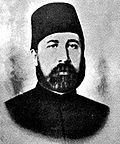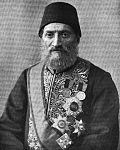| Grand Vizier |
Term of office |
Sultan |
|---|
| Portrait |
Epithet
Name
(Birth–Death) |
Took office |
Left office |
Time in office |
|
Çandarlızade Halil Pasha the Younger
(d. 1453) |
1439 |
1 June
1453 †
(Imprisoned, executed) |
14 years, 151 days |
Murad II

(1446–1451) |
Mehmed II
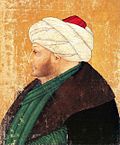
(1444–1446) |
Murad II

(1446–1451) |
Mehmed II

(1451–1481) |
|
|
Zaganos Pasha
(d. 1469) |
1453 |
1456 |
3 years |
 |
Mahmud Pasha Angelović
(1420–1474)
First term |
1456 |
1468 |
12 years |
|
Rum
Mehmed Pasha
(d. 1470) |
1468 |
1469 |
1 year |
|
İshak Pasha
(d. 1487)
First term |
1469 |
1472 |
3 years |
 |
Mahmud Pasha Angelović
(1420–1474)
Second term |
1472 |
1474 †
(Executed) |
2 years |
|
Gedik Ahmed Pasha
(d. 1482) |
1474 |
1477 |
3 years |
|
Karamani Mehmed Pasha
(d. 1481) |
1477 |
4 May
1481 †
(Executed) |
4 years |
|
İshak Pasha
(d. 1487)
Second term |
1481 |
1482 |
1 year |
Bayezid II

(1481–1512) |
|
Koca
Davud Pasha
(1446–1498) |
1482 |
1497 |
15 years |
|
Hersekzade Ahmed Pasha
(1459–1517)
First term |
1497 |
1498 |
1 year |
|
Çandarlızade Ibrahim Pasha the Younger
(1429–1499) |
1498 |
1499 †
(Died in office) |
1 year |
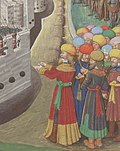 |
Mesih Pasha Palaiologos
(d. 1501) |
1499 |
November
1501 †
(Died in office) |
2 years |
|
Hadım
Ali Pasha
(d. 1511)
First term |
1501 |
1503 |
2 years |
|
Hersekzade Ahmed Pasha
(1459–1517)
Second term |
1503 |
1506 |
3 years |
|
Hadım
Ali Pasha
(d. 1511)
Second term |
1506 |
July
1511 †
(Fell in battle) |
5 years |
|
Hersekzade Ahmed Pasha
(1459–1517)
Third term |
1511 |
1511 |
59 days |
|
Koca
Mustafa Pasha
(d. 1512) |
1511 |
1512 †
(Executed) |
1 year |
|
Hersekzade Ahmed Pasha
(1459–1517)
Fourth term |
1512 |
28 November
1514 |
2 years, 331 days |
Selim I
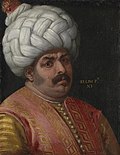
(1512–1520) |
|
Dukakinzade Ahmed Pasha
(d. 1515) |
18 December
1514 |
8 September
1515 †
(Executed) |
264 days |
|
Hersekzade Ahmed Pasha
(1459–1517)
Fifth term |
8 September
1515 |
26 April
1516 |
231 days |
|
Hadım
Sinan Pasha Borovinić
(1459–1517) |
26 April
1516 |
22 January
1517 †
(Fell in battle) |
271 days |
 |
Yunus Pasha
(d. 1517) |
22 January
1517 |
13 September
1517 †
(Executed) |
234 days |
 |
Piri
Mehmed Pasha
(1465–1532) |
25 January
1518 |
27 June
1523 |
5 years, 153 days |
Suleiman I
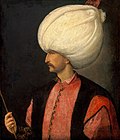
(1520–1566) |
 |
Pargalı
İbrahim Pasha
(1495–1536) |
27 June
1523 |
14 March
1536 †
(Executed) |
12 years, 261 days |
 |
Ayas Mehmed Pasha
(1483–1539) |
14 March
1536 |
13 July
1539 †
(Died in office) |
3 years, 121 days |
 |
Çelebi
Lütfi Pasha
(1488–1564) |
13 July
1539 |
April
1541 |
1 year, 262 days |
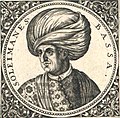 |
Hadım
Süleyman Pasha
(1467–1547) |
April
1541 |
28 November
1544 |
3 years, 241 days |
 |
Damat
Rüstem Pasha
(1500–1561)
First term |
28 November
1544 |
6 October
1553 |
8 years, 312 days |
|
Kara
Ahmed Pasha
(d. 1555) |
6 October
1553 |
29 September
1555 †
(Executed) |
1 year, 358 days |
 |
Damat
Rüstem Pasha
(1500–1561)
Second term |
29 September
1555 |
10 July
1561 †
(Died in office) |
5 years, 284 days |
|
Semiz Ali Pasha
(d. 1565) |
10 July
1561 |
28 June
1565 †
(Died in office) |
3 years, 353 days |
 |
Sokollu
Mehmed Pasha
(1506–1579) |
|
12 October
1579 †
(Assassinated) |
14 years, 106 days |
28 June
1565 |
Selim II

(1566–1574) |
|
Murad III

(1574–1595) |
|
Semiz Ahmed Pasha
(1492–1580) |
12 October
1579 |
27 April
1580 †
(Died in office) |
199 days |
 |
Kara Lala
Mustafa Pasha
(1500–1580) |
28 April
1580 |
7 August
1580 †
(Died in office) |
101 days |
 |
Koca
Sinan Pasha
(1506–1596)
First term |
7 August
1580 |
6 December
1582 |
2 years, 121 days |
|
Kanijeli
Siyavuş Pasha
(d. 1602)
First term |
24 December
1582 |
25 July
1584 |
1 year, 214 days |
 |
Özdemiroğlu Osman Pasha
(1526–1585) |
28 July
1584 |
29 October
1585 †
(Died in office) |
1 year, 93 days |
|
Hadım
Mesih Pasha
(d. 1589) |
1 November
1585 |
14 April
1586 |
164 days |
|
Kanijeli
Siyavuş Pasha
(d. 1602)
Second term |
14 April
1586 |
2 April
1589
(Deposed) |
2 years, 353 days |
 |
Koca
Sinan Pasha
(1506–1596)
Second term |
14 April
1589 |
1 August
1591 |
2 years, 109 days |
 |
Serdar Ferhad Pasha
(d. 1595)
First term |
1 August
1591 |
4 April
1592 |
247 days |
|
Kanijeli
Siyavuş Pasha
(d. 1602)
Third term |
4 April
1592 |
28 January
1593 |
299 days |
 |
Koca
Sinan Pasha
(1506–1596)
Third term |
28 January
1593 |
16 February
1595 |
2 years, 19 days |
Mehmed III

(1595–1603) |
 |
Serdar Ferhad Pasha
(d. 1595)
Second term |
16 February
1595 |
7 July
1595 |
141 days |
 |
Koca
Sinan Pasha
(1506–1596)
Fourth term |
7 July
1595 |
19 November
1595 |
135 days |
 |
Lala Tekeli
Mehmed Pasha
(d. 1595) |
19 November
1595 |
28 November
1595 †
(Died in office) |
9 days |
 |
Koca
Sinan Pasha
(1506–1596)
Fifth term |
1 December
1595 |
3 April
1596 †
(Died in office) |
124 days |
|
Damat
Ibrahim Pasha
(1517–1601)
First term |
4 April
1596 |
27 October
1596 |
206 days |
 |
Cığalazâde Yusuf Sinan Pasha
(1545–1605) |
27 October
1596 |
5 December
1596 |
39 days |
|
Damat
Ibrahim Pasha
(1517–1601)
Second term |
5 December
1596 |
3 November
1597 |
332 days |
|
Hadım
Hasan Pasha
(d. 1598) |
3 November
1597 |
9 April
1598 †
(Imprisoned, executed) |
157 days |
|
Cerrah
Mehmed Pasha
(d. 1604) |
9 April
1598 |
6 January
1599 |
272 days |
|
Damat
Ibrahim Pasha
(1517–1601)
Third term |
6 January
1599 |
10 July
1601 †
(Died in office) |
2 years, 185 days |
|
Damat Yemişçi
Hasan Pasha
(1535–1603) |
22 July
1601 |
4 October
1603 †
(Executed) |
2 years, 74 days |
|
Malkoç Yavuz Ali Pasha
(d. 1604) |
16 October
1603 |
26 July
1604 †
(Died in office) |
253 days |
Ahmed I

(1603–1617) |
|
Lala
Sokolluzade Mehmed Pasha
(d. 1606) |
5 August
1604 |
21 June
1606 †
(Died in office) |
1 year, 320 days |
|
Boşnak
Derviş Mehmed Pasha
(1569–1606) |
21 June
1606 |
9 December
1606 †
(Executed) |
171 days |
 |
Kuyucu
Murad Pasha
(1535–1611) |
11 December
1606 |
5 August
1611 †
(Died in office) |
4 years, 237 days |
|
Damat Gümülcineli
Nasuh Pasha
(d. 1614) |
5 August
1611 |
17 October
1614 †
(Executed) |
3 years, 73 days |
 |
Öküz Kul Kıran
Mehmed Pasha
(d. 1619)
First term |
17 October
1614 |
17 November
1616 |
2 years, 31 days |
|
Damat
Halil Pasha
(1570–1629)
First term |
|
18 January
1619 |
2 years, 62 days |
17 November
1616 |
Mustafa I

(1617–1618) |
|
Osman II

(1618–1622) |
 |
Öküz Kul Kıran
Mehmed Pasha
(d. 1619)
Second term |
18 January
1619 |
23 December
1619 †
(Assassinated) |
339 days |
|
Güzelce
Ali Pasha
(d. 1621) |
23 December
1619 |
9 March
1621 †
(Died in office) |
1 year, 76 days |
|
Ohrili
Hüseyin Pasha
(d. 1622)
First term |
9 March
1621 |
17 September
1621 |
192 days |
|
Dilaver Pasha
(d. 1622) |
17 September
1621 |
19 May
1622 †
(Lynched) |
244 days |
|
Ohrili
Hüseyin Pasha
(d. 1622)
Second term |
19 May
1622 |
20 May
1622 †
(Lynched) |
1 day |
|
Kara
Davud Pasha
(1570–1623) |
20 May
1622 |
13 June
1622 †
(Executed) |
24 days |
Mustafa I

(1622–1623)
|
|
Mere
Hüseyin Pasha
(d. 1624)
First term |
13 June
1622 |
8 July
1622 |
25 days |
|
Lefkeli
Mustafa Pasha
(d. 1648) |
8 July
1622 |
21 September
1622 |
75 days |
Murad IV

(1623–1640) |
|
Hadım
Mehmed Pasha
(d. 1626) |
21 September
1622 |
5 February
1623 |
137 days |
|
Mere
Hüseyin Pasha
(d. 1624)
Second term |
5 February
1623 |
30 August
1623 |
206 days |
|
Kara Kemankeş
Ali Pasha
(d. 1624) |
30 August
1623 |
3 April
1624 †
(Executed) |
217 days |
|
Çerkez
Mehmed Ali Pasha
(d. 1625) |
3 April
1624 |
28 January
1625 †
(Died in office) |
300 days |
|
Hafız
Müezzinzade Ahmed Pasha
(1564–1632)
First term |
8 February
1625 |
1 December
1626 |
1 year, 296 days |
|
Damat
Halil Pasha
(1570–1629)
Second term |
1 December
1626 |
6 April
1628 |
1 year, 127 days |
|
Gazi
Ekrem Hüsrev Pasha
(d. 1632) |
6 April
1628 |
25 October
1631 |
3 years, 202 days |
|
Hafız
Müezzinzade Ahmed Pasha
(1564–1632)
Second term |
25 October
1631 |
10 February
1632 †
(Lynched) |
108 days |
|
Topal
Recep Pasha
(d. 1632) |
10 February
1632 |
18 May
1632 †
(Executed) |
98 days |
|
Tabanıyassı
Mehmed Pasha
(1589–1637) |
18 May
1632 |
2 February
1637 |
4 years, 260 days |
|
Bayram Pasha
(d. 1638) |
2 February
1637 |
26 August
1638 |
1 year, 205 days |
|
Tayyar
Mehmed Pasha
(d. 1638) |
27 August
1638 |
24 December
1638 †
(Fell in battle) |
119 days |
|
Kara Kemankeş
Mustafa Pasha
(1592–1644) |
23 December
1638 |
31 January
1644 †
(Executed) |
5 years, 39 days |
Ibrahim

(1640–1648) |
|
Sultanzade Mehmet Pasha
(1603–1646) |
31 January
1644 |
17 December
1645 |
1 year, 320 days |
|
Nevesinli
Salih Pasha
(d. 1647) |
17 December
1645 |
16 September
1647 †
(Executed) |
1 year, 273 days |
|
Kara
Musa Pasha
(d. 1649) |
16 September
1647 |
21 September
1647 |
5 days |
|
Hazarpare
Ahmet Pasha
(d. 1648) |
21 September
1647 |
8 August
1648 †
(Lynched) |
322 days |
|
Sofu
Mehmed Pasha
(d. 1649) |
8 August
1648 |
21 May
1649 †
(Exiled, executed) |
286 days |
Mehmed IV

(1648–1687) |
|
Kara Dev
Murat Pasha
(1595–1655)
First term |
21 May
1649 |
5 August
1651 |
2 years, 76 days |
|
Damat Melek
Ahmed Pasha
(1604–1662) |
5 August
1651 |
21 August
1651 |
16 days |
|
Abaza
Siyavuş Pasha the Elder
(d. 1656) |
21 August
1651 |
27 September
1651 |
37 days |
 |
Gürcü
Mehmed Pasha
(d. 1665) |
27 September
1651 |
20 June
1652 |
267 days |
|
Tarhoncu
Ahmed Pasha
(d. 1653) |
20 June
1652 |
21 March
1653 †
(Executed) |
274 days |
|
Koca
Dervish Mehmed Pasha
(d. 1655) |
21 March
1653 |
28 October
1654 |
1 year, 221 days |
|
İpşiri Mustafa Pasha
(1607–1655) |
28 October
1654 |
11 May
1655 †
(Executed) |
195 days |
|
Kara Dev
Murat Pasha
(1595–1655)
Second term |
11 May
1655 |
19 August
1655 |
100 days |
|
Ermeni
Suleyman Pasha
(1607–1687) |
19 August
1655 |
28 February
1656 |
193 days |
|
Deli Gazi
Hüseyin Pasha
(d. 1659) |
28 February
1656 |
5 March
1656 |
6 days |
|
Zurnazen Mustafa Pasha
(d. 1666) |
5 March
1656 |
5 March
1656
(Deposed) |
4 hours[5] |
|
Abaza
Siyavuş Pasha the Elder
(d. 1656) |
5 March
1656 |
25 April
1656 †
(Died in office) |
51 days |
|
Boynuyaralı
Mehmed Pasha
(d. 1665) |
26 April
1656 |
15 September
1656 |
142 days |
 |
Köprülü
Mehmed Pasha
(1575–1661) |
15 September
1656 |
31 October
1661 †
(Died in office) |
5 years, 46 days |
 |
Köprülüzade Fazıl Ahmed Pasha
(1635–1676) |
31 October
1661 |
3 November
1676 †
(Died in office) |
15 years, 3 days |
 |
Kara Merzifonlu
Mustafa Pasha
(1635–1683) |
19 October
1676 |
25 December
1683 †
(Executed) |
7 years, 67 days |
 |
Kara
İbrahim Pasha
(d. 1687) |
15 December
1683 |
18 November
1685 |
1 year, 338 days |
|
Sarı
Süleyman Pasha
(d. 1687) |
18 November
1685 |
18 September
1687 †
(Deposed) |
3 years, 304 days |
|
Abaza
Siyavuş Pasha the Younger
(d. 1688) |
18 September
1687 |
23 February
1688 †
(Murdered) |
158 days |
| Suleiman II

(1687–1691)
|
|
Ayaşlı
İsmail Kemalettin Pasha
(1620–1690) |
23 February
1688 |
2 May
1688 |
69 days |
|
Bekri
Mustafa Pasha
(d. 1690) |
30 May
1688 |
7 November
1689 |
1 year, 161 days |
|
Gazi
Köprülüzade Fazıl Mustafa Pasha
(1637–1691) |
10 November
1689 |
19 August
1691 †
(Fell in battle) |
1 year, 282 days |
Ahmed II

(1691–1695) |
|
Arabacı
Bahadırzade Ali Pasha
(1620–1693) |
24 August
1691 |
21 March
1692 |
210 days |
|
Hacı
Çalık Ali Pasha
(d. 1698) |
23 March
1692 |
17 March
1693 |
359 days |
|
Bozoklu
Mustafa Pasha
(1638–1698) |
17 March
1693 |
13 March
1694 |
360 days |
|
Sürmeli
Ali Pasha
(1645–1695) |
13 March
1694 |
22 April
1695 |
359 days |
| Mustafa II

(1695–1703)
|
|
Elmas
Mehmed Pasha
(1661–1697) |
3 May
1695 |
11 September
1697 †
(Fell in battle) |
2 years, 131 days |
 |
Amcazade Köprülü Hüseyin Pasha
(1644–1702) |
17 September
1697 |
4 September
1702 |
4 years, 352 days |
|
Daltaban
Mustafa Pasha
(d. 1703) |
4 September
1702 |
24 January
1703 †
(Executed) |
142 days |
|
Rami Mehmed Pasha
(1645–1706) |
25 January
1703 |
22 August
1703
(Deposed) |
209 days |
|
Nişancı
Kavanoz Ahmed Pasha
(d. 1705) |
22 August
1703 |
16 November
1703 |
86 days |
Ahmed III
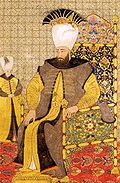
(1703–1730) |
|
Damat
Hasan Pasha
(1658–1713) |
18 November
1703 |
28 September
1704 |
315 days |
|
Hacı Kalaylıkoz
Ahmed Pasha [tr]
(d. 1715) |
October
1704 |
25 December
1704 |
85 days |
 |
Baltacı
Mehmed Pasha
(1652–1712)
First term |
25 December
1704 |
3 May
1706 |
1 year, 129 days |
 |
Damat Çorlulu
Ali Pasha
(1670–1711) |
3 May
1706 |
15 June
1710 |
4 years, 43 days |
|
Köprülüzade Numan Pasha
(1670–1719) |
16 June
1710 |
17 August
1710 |
62 days |
 |
Baltacı
Mehmed Pasha
(1652–1712)
Second term |
18 August
1710 |
20 November
1711 |
1 year, 94 days |
|
Ağa Gürcü
Yusuf Pasha
(d. 1713) |
20 November
1711 |
11 November
1712 |
357 days |
|
Nişancı
Süleyman Pasha
(d. 1715) |
12 November
1712 |
6 April
1713 |
145 days |
|
Hoca Ibrahim Pasha [tr]
(d. 1713) |
6 April
1713 |
7 April
1713 †
(Executed) |
1 day |
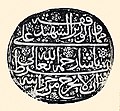 |
Damat Silahdar
Ali Pasha
(1667–1716) |
27 April
1713 |
5 August
1716 †
(Fell in battle) |
3 years, 100 days |
|
Hacı
Halil Pasha
(d. 1733) |
21 August
1716 |
26 August
1717 |
1 year, 5 days |
|
Nişancı
Mehmed Pasha [tr]
(d. 1728) |
26 August
1717 |
9 May
1718 |
256 days |
 |
Damat Nevşehirli
Ibrahim Pasha
(1662–1730) |
9 May
1718 |
1 October
1730 †
(Lynched) |
12 years, 145 days |
|
Damat Silahdar
Mehmed Pasha [tr]
(d. 1737) |
16 October
1730 |
23 January
1731 |
99 days |
Mahmud I

(1730–1754) |
|
Kabakulak
Ibrahim Pasha [tr]
(d. 1743) |
23 January
1731 |
11 September
1731 |
231 days |
 |
Topal
Osman Pasha
(1663–1733) |
21 September
1731 |
12 March
1732 |
173 days |
|
Hekimoğlu Ali Pasha
(1689–1758)
First term |
12 March
1732 |
14 July
1735 |
3 years, 124 days |
|
Gürcü
İsmail Pasha [tr]
(d. 1738) |
14 July
1735 |
25 December
1735 |
164 days |
|
Silahdar Seyyid
Mehmed Pasha [tr]
(d. 1757) |
10 January
1736 |
5 August
1737 |
1 year, 207 days |
|
Muhsinzade Abdullah Pasha [tr]
(1661–1757) |
22 August
1737 |
19 December
1737 |
119 days |
|
Yeğen Mehmed Pasha [tr]
(d. 1745) |
3 December
1737 |
23 March
1739 |
1 year, 110 days |
|
İvazzade Mehmed Pasha
(d. 1743) |
17 March
1739 |
23 June
1740 |
1 year, 98 days |
 |
Nişancı Kör Hacı
Ahmed Pasha
(d. 1753) |
22 July
1740 |
7 April
1742 |
2 years, 259 days |
|
Hekimoğlu Ali Pasha
(1689–1758)
Second term |
21 April
1742 |
4 October
1742 |
166 days |
|
Seyyid
Hasan Pasha
(d. 1748) |
4 October
1742 |
10 August
1746 |
3 years, 310 days |
|
Hacı
Tiryaki Mehmed Pasha [tr]
(1680–1751) |
11 August
1746 |
24 August
1747 |
1 year, 13 days |
|
Seyyid
Abdullah Pasha
(d. 1760) |
24 August
1747 |
2 January
1750 |
2 years, 131 days |
|
Divitdar
Mehmed Emin Pasha
(d. 1753) |
9 January
1750 |
1 July
1752 |
2 years, 174 days |
|
Köse
Bahir Mustafa Pasha
(d. 1765) |
1 July
1752 |
16 February
1755 |
2 years, 230 days |
Osman III

(1754–1757) |
|
Hekimoğlu Ali Pasha
(1689–1758)
Third term |
16 February
1755 |
19 May
1755 |
92 days |
|
Naili Abdullah Pasha
(d. 1758) |
19 May
1755 |
24 August
1755 |
97 days |
|
Nişancı Silahdar Bıyıklı
Ali Paşa [tr]
(d. 1755) |
24 August
1755 |
23 October
1755 †
(Executed) |
60 days |
 |
Yirmisekizzade Mehmed Said Pasha
(d. 1761) |
25 October
1755 |
1 April
1756 |
159 days |
|
Köse
Bahir Mustafa Pasha
(d. 1765)
First term |
30 April
1756 |
3 December
1756 |
217 days |
|
Koca
Mehmet Ragıp Pasha
(1698–1763) |
12 January
1757 |
8 April
1763 †
(Died in office) |
6 years, 86 days |
Mustafa III
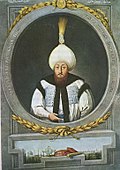
(1757–1774) |
|
Hamza Hamid Pasha [tr]
(1688–1770) |
11 April
1763 |
29 September
1763 |
171 days |
|
Köse
Bahir Mustafa Pasha
(d. 1765)
Second term |
29 September
1763 |
30 March
1765 †
(Dismissed, executed) |
1 year, 213 days |
|
Muhsinzade Mehmed Pasha [tr]
(1704–1774)
First term |
30 March
1765 |
7 August
1768 |
3 years, 130 days |
|
Silahdar
Hamza Mahir Pasha [tr]
(1727–1771) |
7 August
1768 |
20 October
1768 |
74 days |
|
Yağlıkçızade Mehmed Emin Pasha [tr]
(1724–1769) |
20 October
1768 |
12 August
1769 †
(Dismissed, executed) |
296 days |
|
Moldovancı
Ali Pasha [tr]
(d. 1773) |
12 August
1769 |
12 December
1769 |
122 days |
|
İvazzade Halil Pasha
(1724–1777) |
13 December
1769 |
25 December
1770 |
1 year, 12 days |
|
Silahdar Cihangirli
Mehmed Paşa [tr]
(1710–1788) |
25 December
1770 |
11 December
1771 |
351 days |
|
Muhsinzade Mehmed Pasha [tr]
(1704–1774)
Second term |
11 December
1771 |
6 August
1774 †
(Died in office) |
2 years, 238 days |
| Abdul Hamid I

(1774–1789)
|
|
İzzet Mehmed Pasha
(1723–1784)
First term |
11 August
1774 |
7 July
1775 |
330 days |
|
Yağlıkçızade Derviş Mehmed Pasha [tr]
(1735–1777) |
7 July
1775 |
5 January
1777 |
1 year, 182 days |
|
Darendeli
Cebecizade Mehmed Pasha [tr]
(1714–1784) |
5 January
1777 |
1 September
1778 |
1 year, 239 days |
|
Kalafat
Mehmed Pasha [tr]
(d. 1792) |
1 September
1778 |
22 August
1779 |
355 days |
|
Silahdar Seyyid
Mehmed Pasha [tr]
(1735–1781) |
22 August
1779 |
20 February
1781 †
(Died in office) |
1 year, 182 days |
|
İzzet Mehmed Pasha
(1723–1784)
Second term |
20 February
1781 |
25 August
1782 |
1 year, 186 days |
|
Hacı Yeğen
Mehmed Paşa [tr]
(1726–1787) |
25 August
1782 |
31 December
1782 |
128 days |
 |
Halil Hamid Pasha
(1736–1785) |
31 December
1782 |
30 April
1785 †
(Executed) |
2 years, 120 days |
|
Şahin Ali Paşa [tr]
(d. 1789) |
30 April
1785 |
25 January
1786 |
270 days |
 |
Koca
Yusuf Pasha
(1730–1800)
First term |
25 January
1786 |
28 May
1789 |
3 years, 123 days |
| Selim III

(1789–1807)
|
|
Meyyit Kethüda
Hasan Pasha
(d. 1810) |
28 May
1789 |
2 January
1790 |
219 days |
 |
Gazi Cezayirli
Hasan Pasha
(1713–1790) |
2 January
1790 |
30 March
1790 †
(Died in office) |
87 days |
|
Çelebizade Şerif Hasan Pasha
(d. 1791) |
16 April
1790 |
12 February
1791 †
(Assassinated) |
302 days |
 |
Koca
Yusuf Pasha
(1730–1800)
Second term |
12 February
1791 |
1792 |
323 days |
|
Damat
Melek Mehmed Pasha [tr]
(1719–1802) |
1792 |
21 October
1794 |
2 years, 293 days |
|
Safranbolulu
İzzet Mehmet Pasha
(1743–1812) |
21 October
1794 |
23 October
1798 |
4 years, 2 days |
 |
Kör
Yusuf Ziyaüddin Pasha
(d. 1819)
First term |
23 October
1798 |
24 June
1805 |
6 years, 244 days |
|
Bostancıbaşı Hafız
İsmail Pasha [tr]
(1758–1807) |
24 September
1805 |
13 October
1806 |
1 year, 19 days |
|
Keçiboynuzu
İbrahim Hilmi Pasha [tr]
(1747–1825) |
13 October
1806 |
3 June
1807 |
233 days |
| Mustafa IV

(1807–1808)
|
|
Çelebi Mustafa Pasha [tr]
(d. 1811) |
3 June
1807 |
28 July
1808 |
1 year, 55 days |
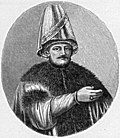 |
Alemdar/Bayrakdar
Mustafa Pasha
(1750–1808) |
29 July
1808 |
15 November
1808 †
(Committed suicide) |
109 days |
Mahmud II

(1808–1839)
|
|
Çavuşbaşı
Memiş Pasha
(d. 1809) |
16 November
1808 |
December
1808 |
15 days |
 |
Çarhacı
Ali Pasha
(d. 1823) |
December
1808 |
March
1809 |
90 days |
 |
Kör
Yusuf Ziyaüddin Pasha
(d. 1819)
Second term |
March
1809 |
February
1811 |
1 year, 337 days |
|
Laz
Aziz Ahmed Pasha
(d. 1819) |
February
1811 |
July
1812 |
1 year, 151 days |
 |
Hurşit Ahmed Pasha
(d. 1822) |
July
1812 |
30 March
1815 |
2 years, 272 days |
 |
Mehmed Emin Rauf Pasha
(1780–1860)
First term |
30 March
1815 |
6 January
1818 |
2 years, 282 days |
|
Burdurlu
Derviş Mehmed Pasha [tr]
(1765–1837) |
6 January
1818 |
5 January
1820 |
1 year, 364 days |
|
Seyyid Ispartalı
Ali Pasha [tr]
(1756–1826) |
5 January
1820 |
21 April
1821 |
1 year, 106 days |
|
Benderli
Ali Pasha
(d. 1821) |
21 April
1821 |
30 April
1821 †
(Executed) |
9 days |
|
Hacı İzmirli
Salih Pasha [tr]
(d. 1828) |
30 April
1821 |
11 November
1822 |
1 year, 195 days |
|
Bostancıbaşı Deli
Abdullah Pasha
(d. 1823) |
11 November
1822 |
4 March
1823 |
113 days |
|
Silahdar
Turnacızade Ali Pasha [tr]
(d. 1829) |
4 March
1823 |
13 December
1823 |
284 days |
|
Mehmed Said Galip Pasha
(1763–1829) |
13 December
1823 |
15 September
1824 |
277 days |
|
Mehmed Selim Pasha
(1771–1831) |
15 September
1824 |
26 October
1828 |
4 years, 41 days |
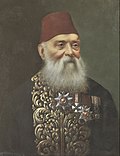 |
Topal
İzzet Mehmed Pasha
(1792–1855)
First term |
26 October
1828 |
28 January
1829 |
94 days |
 |
Reşid Mehmed Pasha
(1780–1836) |
28 January
1829 |
17 February
1833 |
4 years, 20 days |
 |
Mehmed Emin Rauf Pasha
(1780–1860)
Second term |
17 February
1833 |
8 July
1839 |
6 years, 141 days |
Abdulmejid I

(1839–1861) |
 |
Koca
Hüsrev Mehmed Pasha
(1769–1855) |
8 July
1839 |
3 November
1839 |
118 days |
| Proclamation of the Gülhane Edict |
























































































